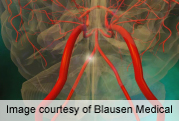
FRIDAY, Jan. 18 (HealthDay News) — People who survive a type of stroke called a subarachnoid hemorrhage still have a higher risk of death, particularly if they continue to smoke and do not keep their blood pressure and cholesterol levels low, a new study warns.
A subarachnoid hemorrhage occurs when a blood vessel just outside the brain bursts and the area between the brain and skull fills with blood.
The study included 233 people in Finland who were alive one year after suffering a subarachnoid hemorrhage. They were followed for an average of nearly nine years. During that time, 88 (about 38 percent) of the patients died. The death rate for the subarachnoid hemorrhage patients was about twice that of the general population.
The increased risk of death among subarachnoid hemorrhage patients was solely due to problems with the blood circulation in the brain, such as stroke or internal bleeding. The risk of death was particularly high among patients who smoked and had high blood pressure and cholesterol levels before the subarachnoid hemorrhage.
The risk of death among subarachnoid hemorrhage survivors was 31 people per 1,000 person-years higher than among people in the general population who did not smoke and low blood pressure and cholesterol levels, the University of Helsinki researchers found.
“In other words, if 20 out of 100 nonsmokers with low blood pressure and cholesterol would die within the next 10 years, the figure for (subarachnoid hemorrhage) survivors would be 51,” study author and neurosurgeon Miikka Korja said in a university news release.
The findings show that it “is particularly important for subarachnoid hemorrhage survivors to refrain from smoking and to take care of their blood pressure and cholesterol levels; apart from age, these are the primary factors behind the increased risk of mortality,” Korja concluded.
The study was published online Jan. 9 in the journal Neurology.
More information
The Brain Aneurysm Foundation has more about subarachnoid hemorrhage.

